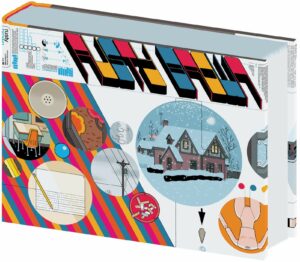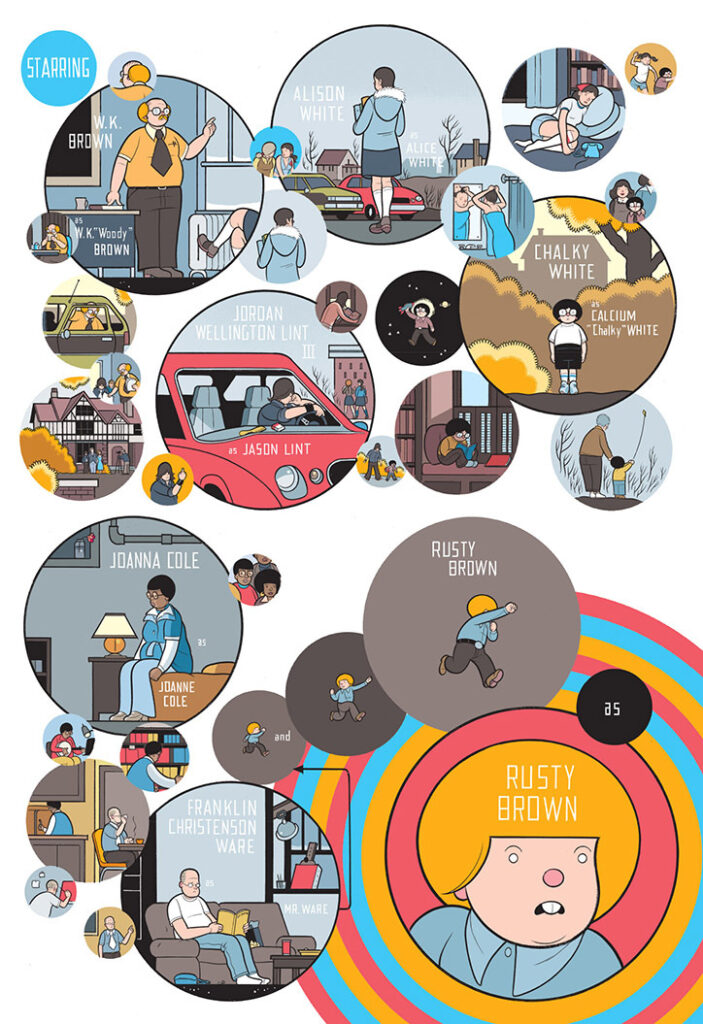
Spiraling Into Infinity
Some time ago, I came into an argument with a friend. We were talking about life after university and the difficult choices that go along with it. “Well”, she said, “all things considered, control is definitely an illusion”. I asked her to elaborate and she replied that because our world is so very complex and we only have a limited set of information to work with, all our decisions are necessarily flawed. We may think we are being rational and in control, but we are more or less like kites in the wind, moved by the forces to which we are oblivious. While I did not necessarily agree with her line of argument, I was strongly reminded of it while reading Rusty Brown, the new comic by Chris Ware.
Throughout his work, and especially in his much-acclaimed graphic novel Jimmy Corrigan, the Smartest Kid on Earth, US cartoonist Ware has exhibited an acute sensibility for the complexities of life. His comics trace the vast web of causalities in which we are entangled as individuals, including our family histories, upbringing and the mental idiosyncrasies of our times. This panoramic mode of storytelling is inseparably linked to Ware’s unique visual style: his drawings are ‘cartoony’ with clear, yet unadorned lines and flat colors that add up to an artificial, sometimes almost sterile appearance.
What makes the artwork so appealing, however, is the way in which Ware arranges his panels on the page. His work often features exhilarating compositional experiments with vast numbers of images sprawling into different directions. Ware’s groundbreaking Jimmy Corrigan from the year 2000 is exemplary for this as it featured complex tableaus that lapsed remarkably from conventional layouts. The book pointed to the fact that, yes, comics should be treated as a “visual language” of their own and that there is still much room for exploration.

Rusty Brown, the new comic by Ware, published in 2019 by Pantheon Press, is in many ways less experimental than Ware’s previous work, which makes for a different, but no less dazzling read. The book, which is around 350 pages in length, revolves around a snowy winter day in 1975 Ohio. In a style that parodies old soap opera TV series, we are introduced to a colorful cast of characters. There’s the ginger-haired Rusty Brown, a painfully introverted boy who is convinced he has superpowers, his father, a melancholy schoolteacher, his new friend Chalky White who just arrived in town, Jordan Lint, a teenaged long-haired troublemaker, and many more.
At first, the lives of all these characters cross in a way reminiscent of high school dramas: there’s a dose of teenage angst, the fear of not belonging, heartbreak and half-hearted rebellion. But there are also adult characters stuck inside their own routines, caught in the daily drudgery. Just as one has gotten used to Rusty Brown’s mode of narration, the tone shifts again. The snowy day in Ohio is not so much as the setting of a scene but the starting point of a spiral into different characters’ lives.
Just as a snowstorm is comprised of countless individual flakes, the narrative of Rusty Brown dives into the lives of people first introduced in passing. Each episode features a distinct visual style which points both to the characters’ inner life and Ware’s development as an artist. While the stories span a variety of subjects and genres (including a pinch of science-fiction), they also share a particular flavor of melancholy and sadness. Like the perspective presented by my friend in the opening anecdote of this review, Ware’s characters often find themselves dazed by the complexity of life while at the same time dreaming of more.

At its most touching, Rusty Brown deals with forms of regret. The episode of Jason Lint in particular, is a devastating roller-coaster ride that sees its character going through a many-stage metamorphosis, from an angry teenage firecracker to family father. It is a character on the run, who trying to escape his own abusive past while involuntarily causing hurt in others. That Jason still feels like a coherent figure undergoing life changes and not a cluster of ideas on paper is evidence of Ware’s strength as a writer and cartoonist. It also matches his own views of seeing art as a medium of empathy.
Rusty Brown is an incredibly ambitious work because it achieves the balance of both relating entire lives of its characters while remaining attuned to the more ephemeral texture of experience, the seemingly mundane and trivial details that constitute our existence. Despite veering away from formal experiments, Ware still proves he is a master of composition and space by presenting unusual and appealing layouts. All in all, Rusty Brown feels highly atmospheric and emotionally charged. The colors are rich and underscore the shifting moods of the different stories and perspectives. Yes, the complexities of life may make any claim of control seem ludicrous. But thankfully, we are not alone and have artists like Ware who can trace our patterns in the void.
Rusty Brown
Chris Ware
2019
Pantheon